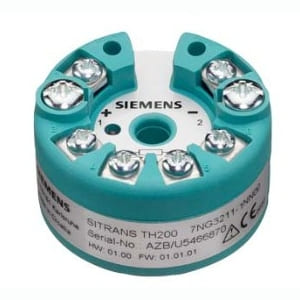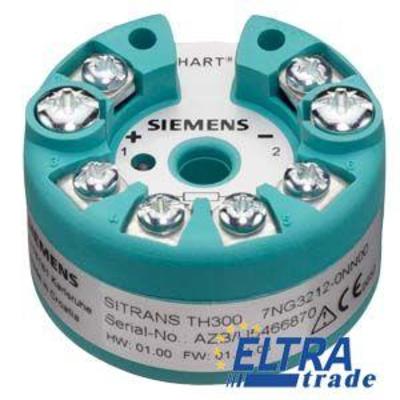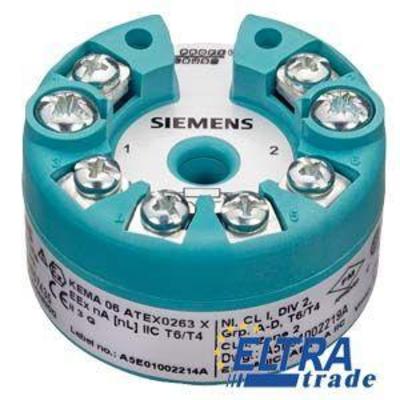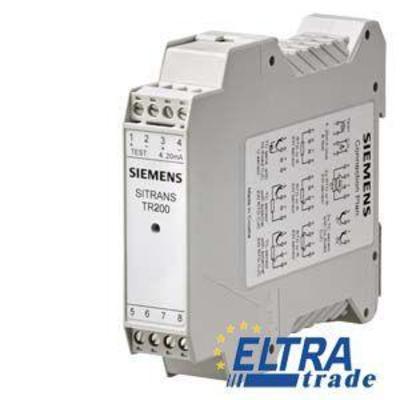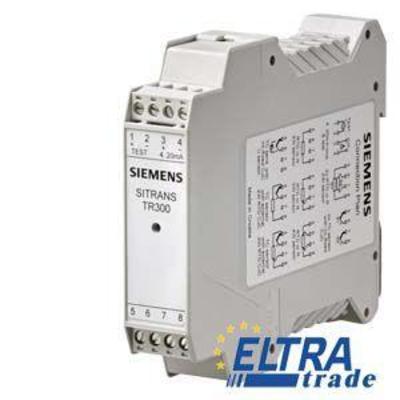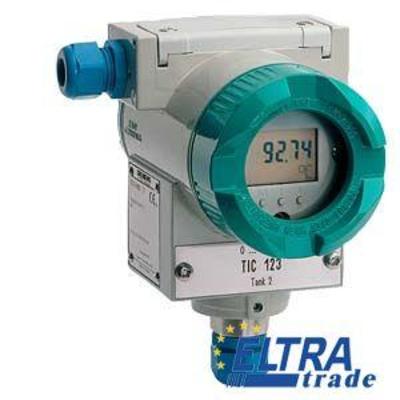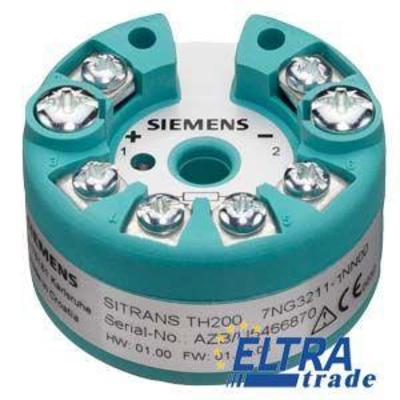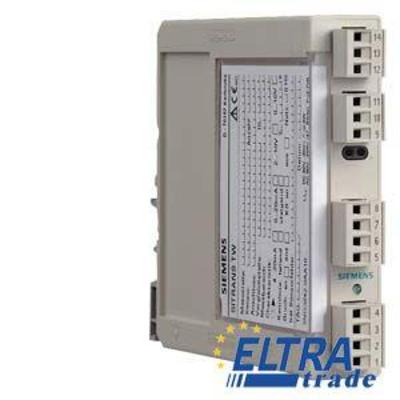Siemens Temperature measurement
Siemens 7NG32111NN00
Temperature transmitter SITRANS TH200
Siemens 7NG32120NN00
TEMPERATURE TRANSMITTER SITRANS TH300 FOR INSTALLATION IN THE CONNECTION HEAD, TYPE B (DIN 43729), TWO-WIRE SYSTEM 4 ... 20 MA, PROGRAMMABLE, COMMUNICATION-CAPABLE ACC. TO HART, WITH ELECTRICAL ISOLATION WITHOUT EXPLOSION PROTECTION . .
Siemens 7NG32140NN00
Siemens 7NG30320JN00
EMPERATURE TRANSMITTER SITRANS TR200, FOR RAIL MOUNTING, 2-WIRE SYSTEM, 4 TO 20 MA, PROGRAMMABLE, WITH GALVANIC ISOLATION, WITH DOCUMENTATION ON CD WITHOUT EXPLOSION PROTECTION .Siemens 7NG30331JN00
TEMPERATURE TRANSMITTER SITRANS TR300, FOR MOUNTING ON A STANDARD DIN RAIL, TWO-WIR SYSTEM, 4 ... 20 MA, HART, WITH ELECTRICAL ISOLATION, WITH DOCUMENTATION ON CD WITH EXPLOSION PROTECTION TO ATEX . . .Siemens 7NG31364AB10
SITRANS TF TEMPERATURE TRANS- MITTER IN HOUSING FOR FIELD MOUNTING, TWO-WIRE SYSTEM 4 TO 20MA, WITH ELECTRICAL ISOLATION, WITH DOCUMENTATION ON CD, INTEGRATED TRANSMITTER: SITRANS TH300, COMMUNICATION CAPABILITY ACCORDING TO HART V5.9, WITH EXPLOSION PROTECTION: EEX D, TOTAL DEVICE SITRANS TF WITHOUT SCREWED GLAND, ENCLOSURE: DIE-CAST ALUMINIUM CONNECTION/CABLE INLETS: SCREW GLANDS M20 X 1,5, WITH DIGITAL INDICATOR WITHOUT MOUNTING BRACKET AND SECURING PARTS,Siemens 7NG32111AN00
TEMPERATURE TRANSMITTER SITRANS TH200 FOR INSTALLATION IN CONNECTION HEAD TYPE B (DIN 43729), TWO-WIRE SYSTEM, 4...20 MA, PRO- GRAMMABLE, WITH ELECTRICAL ISOLATION WITH EXPLOSION PROTECTION TO ATEX . .Siemens 7NG32420AA07
The Product is out of Production!
Contact the manager for more information.
SITRANS TW UNIVERSAL TRANSMITTER FOR RAIL MOUNTING IN FOUR-WIRE SYSTEM WITHOUT EXPLOSION PROTECTION, POWERSUPPLY AC/DC 230 V, OUTPUT SIGNAL: 0/4 TO 20MA, WITHOUT RELAY, CURRENT INPUT: -12 TO 100 MA,
Most technological processes work correctly only at a certain temperature. In addition, the measured temperature indicators help to determine how correctly the expended energy is used. In other words, this is the value that needs to be constantly monitored. All types of temperature measuring instruments are divided into contact and non-contact. They are also classified according to materials, principles and methods of action.
The Siemens portfolio for temperature measurement includes sensors, head, rail and field mount transmitters, as well as complete measuring points. Combined with a range of communication options, you get complete integration of field devices into your plant. Highly accurate, flexible, fully supported: temperature sensors and transmitters do everything you need.
Types of Siemens thermometers according to the principle of operation
The temperature measurement process can be based on different physical processes. Based on this, there are 5 types of thermometers:
- Contact. Such devices are also called expansion thermometers. They are based on tracking changes in the volume of bodies under the influence of changing temperature.
- Resistance thermometers. This category includes devices that are capable of measuring the electrical resistance of substances, which varies depending on temperature. Such thermometers consist of sensitive thermal sensors and precise electronic units that control changes in conductivity, resistance, and electric potential. Usually they are built into the overall monitoring and notification system, where you need to track changing parameters and prevent them from being exceeded.
- Electronic thermocouples. When heated, these devices generate a current, which allows you to measure the temperature. The principle of operation is based on measurements of thermoelectromotive force.
- Gauge. Such thermometers take into account the relationship between temperature and gas pressure. A thermal bulb is placed in the medium to be measured, connected to the manometer by a brass tube. When the bulb is heated, the pressure inside it increases, and this value is measured by a manometer.
- Non-contact pyrometers. At the heart of these devices are infrared sensors that read the level of radiation. They are divided into two types: brightness, conducting measurements of radiation at a certain wavelength, and radiation, when the thermal effect of radiation is determined. They can be used, among other things, to determine the temperature of the heated metal, as well as during commissioning and testing of boilers.
Types of thermometers by materials used
- Liquid. They are a body filled with a liquid that is subject to thermal expansion. The flask with liquid is applied to the scale.
- Gas. The principle of operation is the same as for liquid ones, but an inert gas is chosen as a filler for the flask. This allows you to significantly increase the temperature measurement range. With their help, you can measure the temperature in various hot liquid media.
- Mechanical. The action is based on the principle of deformation of a metal spiral. Often these thermometers are equipped with a pointer “display”. Are established in special equipment, cars, on the automated lines. Insensitive to shock.
- Electrical. They work by measuring the level of resistance of the conductor at different temperature indicators. Different metals can be used as a conductor (for example, copper or platinum). Most often, such models are used in laboratory conditions.
- Thermoelectric. The design includes two conductors. These devices are very accurate, suitable for high-precision measurements in industrial processes.
- Fiber optic. Sensitive fiber optic sensors (it stretches and contracts or stretches with temperature changes, and the device records the degree of refraction of the passing light beam).
- Infrared. Direct contact with the measured substance is not required: the device generates an infrared beam, which is directed to the surface under study. This is a modern type of non-contact thermometers that work with an accuracy of several degrees and are suitable for high temperature measurements. They can even measure the temperature of an open flame.
To buy Siemens Temperature Transmitter Sitrans (7NG) at the best price you can contact our managers.
